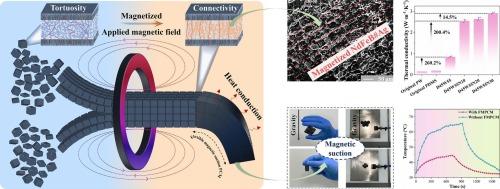具有模块化组装和各向异性的柔性磁吸相变材料用于电池热管理应用
IF 8.9
2区 工程技术
Q1 ENERGY & FUELS
引用次数: 0
摘要
柔性封装相变材料(FPCMs)已被广泛研究,在被动热管理应用中显示出巨大的前景。然而,由于pcm的固有电导率低和填料网络的连续性有限,高效的热传导网络仍然是困难的。在此,我们提出了一种可扩展的磁辅助设计,其中石蜡(PW)嵌入由银壳钕铁硼(NdFeB#Ag)颗粒和基于聚二甲基硅氧烷(PDMS)的碳纳米管(CNTs)网络形成的二维(3D)网络中。施加外加磁场后,在外加磁场下,NdFeB粒子自组装成多孔的链状3D框架,在磁场去除后仍保持稳定,实现了模块化、无容器组装和各向异性热传输。这种磁诱导阵列克服了传统刚性3D骨架模板的局限性,能够与多种聚合物基质无缝集成,同时增强灵活性、机械稳健性和热传输性能,同时确保防泄漏。所得材料的导热系数高达2.97 W·m−1·K−1,潜热大于97 J·g−1,抗压屈服强度为13.19 MPa。在电池热管理中,模块在充放电过程中将表面温度保持在50°C以下,在10C时将峰值温度降低21°C。这项工作为制造多功能fpcm提供了一个通用的途径,为电子冷却和能源系统提供了巨大的潜力。本文章由计算机程序翻译,如有差异,请以英文原文为准。

Flexible magnetic suction phase change materials with modular assembly and anisotropy for battery thermal management applications
Flexible encapsulated phase change materials (FPCMs) have been extensively investigated, demonstrating substantial promise for passive thermal management applications. However, efficient thermal conduction networks remain difficult due to the low intrinsic conductivity of PCMs and limited filler network continuity. Herein, we present a scalable, magnetically assisted design in which paraffin wax (PW) is embedded within a dual three-dimensional (3D) network formed by silver-shelled neodymium iron boron (NdFeB#Ag) particles and a polydimethylsiloxane (PDMS)-based carbon nanotubes (CNTs) network. Upon application of an external magnetic field, under an external field, NdFeB particles self-assemble into a porous, chain-like 3D framework that remains stable after field removal, enabling modular, container-free assembly and anisotropic heat transport. This magnetically induced array overcomes the limitations associated with traditional rigid 3D skeletal templates, enabling seamless integration with diverse polymer matrices to simultaneously enhance flexibility, mechanical robustness, and thermal transport properties while ensuring leakage resistance. The resulting material achieves a thermal conductivity up to 2.97 W·m−1·K−1 while maintaining latent heat more than 97 J·g−1 and compressive yield strength of 13.19 MPa. In battery thermal management, modules keep surface temperatures below 50 °C during charge–discharge and reduce peak temperature by 21 °C at 10C. This work provides a versatile pathway for fabricating multifunctional FPCMs, offering significant potential for electronics cooling and energy systems.
求助全文
通过发布文献求助,成功后即可免费获取论文全文。
去求助
来源期刊

Journal of energy storage
Energy-Renewable Energy, Sustainability and the Environment
CiteScore
11.80
自引率
24.50%
发文量
2262
审稿时长
69 days
期刊介绍:
Journal of energy storage focusses on all aspects of energy storage, in particular systems integration, electric grid integration, modelling and analysis, novel energy storage technologies, sizing and management strategies, business models for operation of storage systems and energy storage developments worldwide.
 求助内容:
求助内容: 应助结果提醒方式:
应助结果提醒方式:


